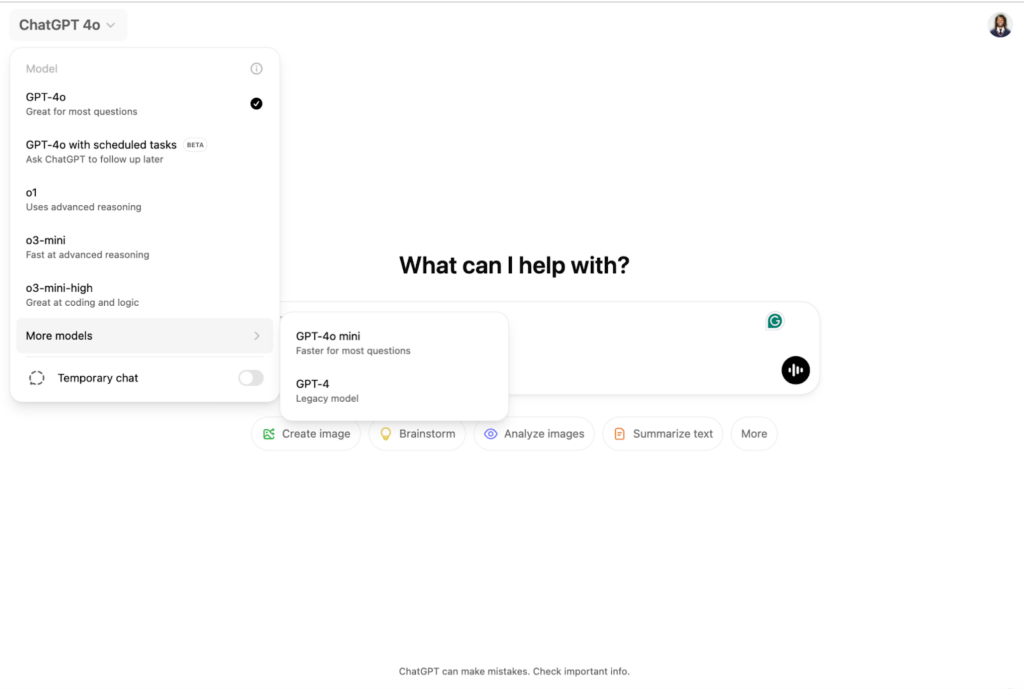|
Getting your Trinity Audio player ready...
|
On February 12, Sam Altman took to X to announce OpenAI’s roadmap for GPT-4.5 and GPT-5.
One of the biggest takeaways is that OpenAI is working to simplify the product lineup. Right now, GPT users can choose between multiple models:
- GPT-4o: Default model, recommended for most queries.
- GPT-4o with Scheduled Tasks: Allows for scheduled responses.
- o1: Optimized for advanced reasoning.
- o3-mini: Fast at advanced reasoning.
- o3-mini-high: Great at coding and logic.
- GPT-4o-mini: Faster for most questions.
- GPT-4: The legacy model.

This is a lot to navigate; if I had to guess, most GPT users probably don’t even realize they have eight different options, which is probably one of the reasons why OpenAI wants to change that.
“A top goal for us is to unify O-series models and GPT-series models by creating systems that can use all our tools, know when to think for a long time or not, and generally be useful for a very wide range of tasks,” Altman explained.
This suggests that OpenAI is working on a more seamless experience, one where the model automatically selects the best tool for the job behind the scenes, eliminating the need for users to switch between different models manually.
Another major announcement from Altman’s roadmap was that GPT-5 is on the way, but before that, OpenAI will release GPT-4.5 in the coming weeks or months. Altman described it as the company’s “last non-chain-of-thought model,” implying that future iterations (like GPT-5) will incorporate chain-of-thought reasoning, which would probably allow users to see step-by-step logic (thought process) behind the AI-generated responses.
Elon Musk’s $97.4 billion bid for OpenAI
Elon Musk escalated his ongoing feud with OpenAI this week by making a $97.4 billion bid to acquire the company. The offer, which significantly undercuts OpenAI’s current $157 billion valuation, was quickly rejected by CEO Sam Altman, who responded to the offer via X with a “no thank you” and a counteroffer to buy Twitter (now X.com).
Musk, who is not known for backing down from public disputes, responded by calling Altman a “swindler.”
While it’s safe to say Musk is certainly serious about his bid, it’s unlikely he expected OpenAI to accept it. Instead, the offer seems more like a calculated move to complicate OpenAI’s transition to a for-profit model since it forces the company to factor in his offer while valuing assets and considering an IPO.
As the CEO of xAI, a direct competitor to OpenAI, Musk’s bid purposely throws a wrench into OpenAI’s operations. Under its current structure, OpenAI’s for-profit arm is still governed by its nonprofit parent, meaning the board must review any serious offers. While this probably won’t derail OpenAI in any significant way, it does create additional hurdles—hurdles that Altman himself suggested are part of Musk’s larger strategy to slow OpenAI’s momentum, alongside the lawsuits Musk has filed against the company.
Beyond strategy, Musk’s motivation to thwart OpenAI is probably personal. He was one of OpenAI’s original founders and a significant donor before stepping down from its board in 2018. Now, as OpenAI pivots to a for-profit model, investors stand to gain from its growth—but Musk, having no equity, is left out of the windfall the company is likely to experience in the future. The fact that Musk fueled the company’s growth in its earliest days yet is not in any position to financially benefit from the company he helped build seems to be a direct cause of his bitterness toward OpenAI and Sam Altman. Musk’s most recent court filing appears to support that idea, as he stated he would withdraw his bid if OpenAI abandoned its for-profit transition.
JD Vance criticizes European AI regulation at Paris AI Summit
At the Paris AI Summit, U.S. Vice President JD Vance made the Trump administration’s stance on artificial intelligence innovation clear to the world: Europe’s regulatory approach is harming the industry.
“We believe that excessive regulation of the AI sector could kill a transformative industry,” Vance told the audience of CEOs and government officials.
“When conferences like this convene to discuss a cutting-edge technology, oftentimes, I think our response is to be too self-conscious, too risk-averse. But never have I encountered a breakthrough in tech that so clearly calls us to do precisely the opposite,” he added.
Europe’s regulatory framework prioritizes consumer rights and data privacy, often requiring a company to navigate additional compliance measures before launching AI products in the EU. This is why when AI leaders like OpenAI release new tools, they often aren’t immediately available in Europe.
The U.S. has taken a much different approach. Since Trump took office, the government has embraced a “growth at all costs” mentality toward AI, prioritizing business expansion over regulatory oversight. Vance doubled down on this, declaring:
“This administration will ensure that American AI technology will continue to be the gold standard worldwide and will be the partner of choice for others, foreign countries, and certainly businesses, as they expand their own use of AI. The United States is the leader in AI, and we plan to keep it that way.”
To reinforce this belief, the U.S. refused to sign the global “Inclusive and Sustainable Artificial Intelligence for People and the Planet” declaration. The agreement promotes ethical AI development, digital inclusivity, and safeguards for underdeveloped nations—principles that could slow AI growth if they were enforced. The U.S.’s decision not to sign the declaration is a clear signal that the country is committed to maintaining a competitive edge in AI at the potential cost of global cooperation.
In order for artificial intelligence (AI) to work right within the law and thrive in the face of growing challenges, it needs to integrate an enterprise blockchain system that ensures data input quality and ownership—allowing it to keep data safe while also guaranteeing the immutability of data. Check out CoinGeek’s coverage on this emerging tech to learn more why Enterprise blockchain will be the backbone of AI.
Watch The Future Internet: Uniting Blockchain, AI & IPv6

 12-23-2025
12-23-2025 




